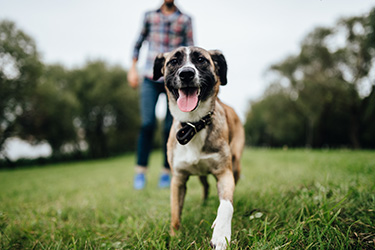How to Help a Choking Pet

How to help your pet in case of choking
Choking is a common pet emergency, but timing is critical. Pet owners should consider keeping these tips in their pet first-aid kit, so they know what to do in case of an emergency.
Is it coughing or is it choking?
Know the signs of coughing versus choking. Choking can be caused either by an item lodged in the animal’s throat or by something wrapped tightly around a pet’s neck. Frequent coughing, with periods of normal breathing in between, is likely not choking. Animals that are choking will show signs including:
- Extreme distress or agitation
- Excessive drooling
- Pawing at the mouth
- Gagging
- Retching
- Labored breathing
- Fainting or unconsciousness
Performing the Heimlich maneuver
In an emergency, it’s important to restrain the animal, as they will struggle and may try to bite in their panic. If an item is wrapped around the neck, carefully cut with scissors. Open the mouth and look inside. If possible, look in or sweep the mouth. If the pet is unconscious and not breathing, open the mouth and pull the tongue forward. If the object is clearly visible and within reach, you can try to remove it with tweezers. Never reach for an object with your fingers if it is lodged at the back of the throat; you may mistakenly push it further back.
If you can’t safely remove the object but you can get your pet to an emergency vet, do so immediately. If that is unsuccessful, petmd.com shares these steps to perform the Heimlich maneuver on cats.
- Place the cat on his side.
- Put one hand along his back.
- Put the other hand on his belly, just below the ribs.
- With the hand on the belly, give several sharp pushes in and up.
- Check the mouth for foreign objects and remove them, then close the mouth and give a couple of small breaths through the nose.
- Repeat these steps until there is no foreign object present in the airway.
If there are two people and a small dog has collapsed, vets-now.com recommends the following:
- Hold the dog’s back against your stomach (head up, paws down).
- Find the soft hollow under the ribs. A closed fist should fit into this spot.
- Pull up and in two or three times, toward your own stomach, using a thrusting motion.
- If the dog is too large to lift, place him on his side and kneel behind his back.
- Place your closed fist in the hollow under his rib cage.
- Push upward and inward sharply, in the direction of your dog’s head and your knees.
If it’s a very small dog, place two knuckles of one hand on the dog’s stomach, just below the ribs, and the other hand flat on his back to steady him. Give a quick, hard poke upwards with your knuckles.
If the animal is still not breathing after the foreign object has been removed, check for a heartbeat or pulse. If none can be found, begin CPR and/or artificial respiration as needed and take your pet to the veterinarian immediately. The American Red Cross shares these tips for cat and dog CPR:
1. Check to see if the pet is breathing and check for a heartbeat.
If you do not see your pet’s chest moving and cannot find a heartbeat, begin CPR with chest compressions.
2. Perform 30 chest compressions.
For cats, small dogs and deep chested dogs, place the heel of one of your hands directly over the pet’s heart and place your other hand directly over the first hand.
For deep chested dogs, place the heel of one hand over the widest part of the chest and place your other hand directly over the first hand.
For barrel chested dogs, place the dog on its back, place one hand over the widest part of the sternum, and place your other hand directly over the first hand. Lock your elbows and make sure your shoulders are directly above your hands.
Then, push hard and push fast at a rate of 100-120 compressions per minute, compressing 1/3 to 1/2 the width of your pet’s chest. Make sure the chest comes back fully (recoils) before compressing again.
3. Give rescue breaths.
Gently close the pet’s mouth and extend the pet’s neck to open the airway. Cover your pet’s nose with your mouth and exhale until you see the pet’s chest rise. Give a second rescue breath.
4. Continue CPR with a cycle of 30 chest compressions and 2 rescue breaths until your dog or cat begins breathing again on its own.
5. Check for breathing and a heartbeat every 2 minutes.
6. Get help. Continue CPR until you reach a veterinary hospital.
Contact your sales representative at 855.724.3461 or reach out online.
Sources:
https://www.vets-now.com/pet-care-advice/choking-in-dogs/
https://www.petmd.com/cat/emergency/common-emergencies/e_ct_choking_and_heimlich_maneuver
https://www.petmd.com/cat/emergency/common-emergencies/e_ct_respiration_cpr
https://www.vets-now.com/pet-care-advice/choking-in-dogs/
https://drbattiersveterinaryclinic.com/services/what-to-do-if-your-dog-is-choking/
https://www.redcross.org/take-a-class/cpr/performing-cpr/pet-cpr
Need Regulatory Assistance
If you need help with regulatory or licensing issues, we're happy to help. We have a wide variety of resources to help you when issues arise.

Careers
Are you looking for a place to let your talents shine? At Covetrus, we help our practitioner customers better serve their patients and take pride in providing the best customer experience possible. Search our open positions to see our available opportunities.
Newsletter
Stay current with what’s going on with Covetrus, subscribe to receive our newsletter and email communications. Subscribers will receive the latest information in practice management, sales and marketing, animal health, and more.


Leave a comment